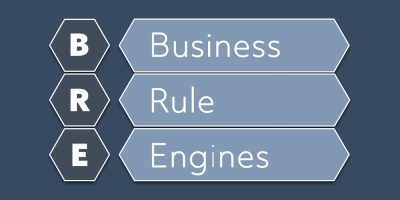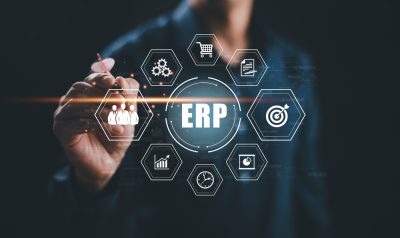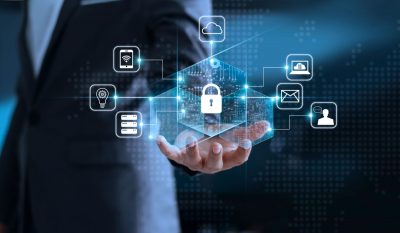Highlights:
- All data is gathered on the server and made quickly available to individuals with access once all departments are integrated with the system.
- ERP is able to access real-time data from many company departments, which allow these systems to identify important patterns and offer comprehensive business insights.
Enterprise resource planning (ERP) is a platform businesses use to coordinate and manage the key elements of their operations. Numerous ERP software programs are essential to businesses because they enable resource planning by integrating all the operations required to operate their functions into a single system.
An ERP software system can encompass functions such as planning, inventory procurement, sales, marketing, finance, and more, providing a comprehensive solution for managing various aspects of a business’s operations.
An enterprise resource planning system connects the diverse computer systems within a large organization. Each department would have its own system for specific tasks without an ERP program. However, implementing ERP software allows all these systems to be accessed through a unified application with a streamlined interface. This integration allows for seamless communication and data sharing across departments, fostering collaboration and efficiency within the organization.
Significance of ERP in Business
ERP systems have become commonplace for businesses seeking efficient resource allocation. They can aid in reallocating people and financial resources or developing fundamental business procedures that are more cost-effective without compromising on quality or performance.
When it comes to cooperation and planning, an ERP is also functional. Employees have comprehensive visibility into current inventory, customer orders, supplier purchase orders, and projected future demand. They can make necessary adjustments to prevent issues. As employees can check on the state of other departments to inform their own decisions, ERP software also enhances communication and collaboration.
Functioning of ERP
Over the years, traditional ERP software models that relied on physical client servers and manual data entry systems have been replaced by cloud-based ERP solutions, offering remote, web-based access. The platform is typically maintained by the software provider, while client businesses opt to lease the platform’s services.
Organizations choose the applications they want to employ. Following that, the hosting provider proceeds to install the applications on the rented server, initiating the integration of the client’s operations and data into the platform.
All data is gathered on the server and made quickly available to individuals with access once all departments are integrated with the system. Reports can be generated using metrics, charts, or other visual aids and tools that clients need to evaluate the performance of their company and its departments.
General Modules of ERP
Each ERP module supports a particular set of business operations and gives employees in that department the information and access they require to perform their duties. Each module is connected to the ERP system, which provides departments with accurate, shared data from a single source of truth. Following are the popular ERP modules:
Finance
The core of most ERP systems is the finance and accounting module. Businesses may handle accounts payable (AP) and accounts receivable (AR), close the books quickly, prepare financial reports, adhere to revenue recognition requirements, reduce financial risk, and more with its assistance. It also manages the general ledger and automates important financial operations.
Sales
With data-driven insights, the sales module assists reps in increasing sales and targeting leads with the ideal promotions and upsell chances. It also keeps track of contacts with prospects and customers. It features order administration, contracts, billing, sales performance management, and sales force assistance for the order-to-cash process.
HR Management
Most ERP systems have an HR module offering fundamental features such as payroll, time, and attendance. The ERP can be connected to add-ons or full human capital management (HCM) suites to give more sophisticated HR functions, including employee experience management and workforce analytics.
Supply Chain and Logistics Management
The supply chain module, another essential part of ERP systems, tracks how products are moved across a company’s supply chain. The module offers resources for real-time inventory management, warehousing operations, shipping, and logistics, which can improve the visibility and resiliency of the supply chain.
Service
The service module within an ERP empowers businesses to deliver reliable and personalized customer service, meeting the expectations of their clients. It encompasses features such as in-house repairs, spare parts management, field service management, and service-based revenue generation. Moreover, it provides analytics to support service representatives and technicians in promptly resolving customer issues and enhancing customer loyalty.
ERP Deployment Methods
Modern ERP systems can be installed on-premises, in a private or public cloud, or in a variety of hybrid deployment scenarios that blend environments.
On-premise ERP
This deployment approach provides you with full control as the software is usually deployed within your own data center, based on your preferred location. Your team takes responsibility for hardware and software installation and maintenance, ensuring complete ownership and management of the ERP system.
Many businesses are updating and modernizing their on-premise ERP systems to deploy them in the cloud. This necessitates meticulous planning of your ERP upgrade and a thorough evaluation of ERP software and deployment choices.
Cloud ERP
Cloud ERP delivers software over the internet as a subscription-based service hosted in the cloud. The software provider handles regular maintenance, security, and updates on your behalf. Cloud ERP is the favored deployment strategy due to several advantages, such as lower upfront costs, enhanced scalability and flexibility, seamless integration, and more.
Hybrid ERP
The hybrid cloud ERP approach is available for businesses that want to combine the two to fit their needs. Your ERP software and data may be in the cloud and on-premises at this point. Two-tier ERP is another name for this.
Future Trends of ERP
With an awareness of the immense benefits that an ERP system offers, companies are actively exploring avenues for improvement. Today’s ERP solutions advancements are driven by cutting-edge technologies such as artificial intelligence, blockchain, augmented reality, and the Internet of Things (IoT). Many of these technologies are seamlessly integrated into leading ERP platforms, enabling businesses to leverage their capabilities for enhanced efficiency and productivity.
For instance, AI and ML can automate account reconciliations and identify transactions that require further investigation. This frees up the accounting team’s time and delegates a duty most don’t enjoy. As more transactions are processed, ML technology gets better and can aid in creating more precise estimates.
Blockchain can improve supply chain transparency by securely encrypting data and packaging it. In particular, it may provide a thorough audit trail of a product’s transition from raw material to finished goods and illustrate the status of certain items in detail. Additionally, this gives information from which the ERP can gain understanding.
To acquire a sense of how a rug or 3D furniture representation might look in their living rooms before purchasing, augmented reality has made headway in retail. The ERP can store all the photos and data points required to make AR function.
In addition to these popular technologies, many companies attempt to unify all their apps into one platform. This will happen more frequently as software providers broaden their product lines and more companies see the value of a unified ERP system.
Conclusion
Through a single system, enterprise resource planning (ERP) integrates and organizes corporate activities. Businesses can better plan and allocate resources with a clearer line of sight. In the absence of ERP, organizations often operate in isolated compartments, with each department relying on separate and disconnected systems.
ERP systems foster transparent communication and knowledge sharing within a company, integrating systems to enhance productivity, efficiency, and collaboration across teams and departments. They promote the synergy and cohesion needed for effective organizational functioning.
However, using an ERP system won’t be beneficial if the company’s culture doesn’t change and it doesn’t examine how its organizational structure can support it.
Embark on an exploration with our curated compilation of informative IT Infrastructure whitepapers.





































































